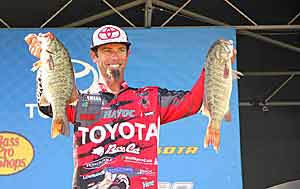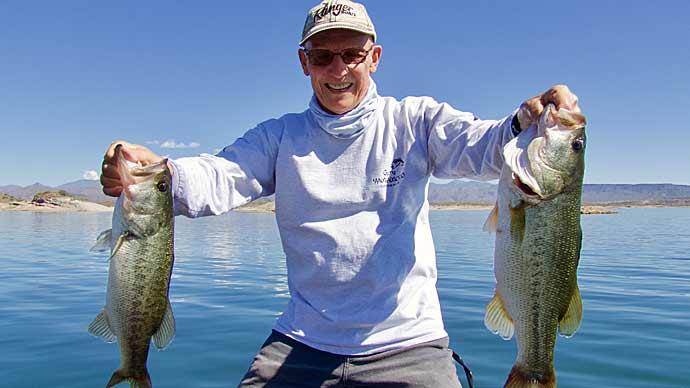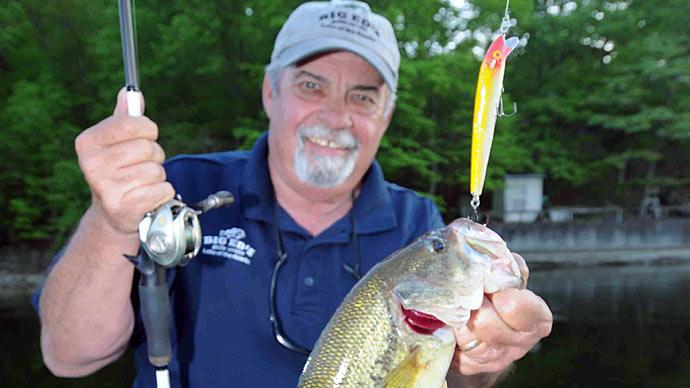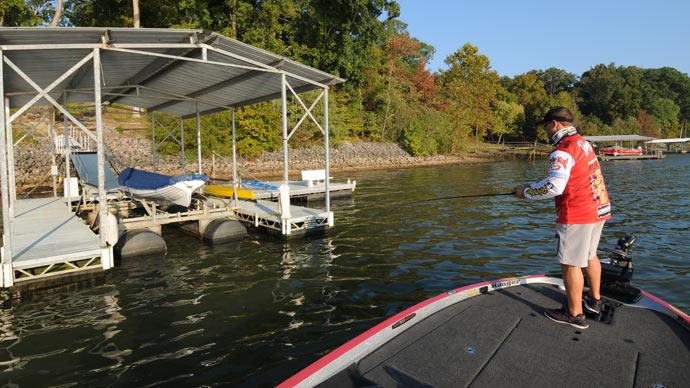
I'm not going to lie to you. One of my favorite ways to catch bass is using a jerkbait. Because I am a true power fisherman, this technique allows me to cover maximum amounts of water and generate the reaction strike I always try to generate. My first major win as a pro was the 1999 B.A.S.S. Top 150 on Lake Champlain came in part to help from a jerkbait. So, let's discuss the when, what, and where of jerk baiting.
The when, what, and where aspects of jerk baiting are closely interconnected. So with this in mind, let's break jerkbaits down by season first, and then go into detail about where to fish them and which kinds to fish. Remember, jerkbaits are among the few baits that are genuinely effective the whole year.
Winter Period (water temp 40-55 degrees)
Even during the cold-water period, when the fish are inactive and more vertical in their location, the jerkbait can be an effective tool. Generally, during this period, the bass will be found in areas with more vertical depth breaks, like the main lake dam and point areas and areas in coves and creeks where the steepest banks exist.
The jerkbait can shine during these times, especially after one or two more stable, warmer weather days. What happens is that after a brief stable or warming trend, the bass will use the small lips or shelves in their wintering areas. This could mean getting shallower on the vertical breakline or shifting to a nearby flat or lip. It puts the bass in an area that is a more accessible depth range for the jerkbait to be effective.
During the winter period, I select three models of jerkbaits: a sinking or countdown model, a suspending model, and a suspending deep-diving model. With these three types of jerkbaits, I can effectively cover water down to about 16 feet. I use the suspending and sinking models for depths of 10 or 12 feet, and the deep-diver for anything more than 12 feet.
I will use baits that range from as little as three inches to as much as eight inches long. The primary consideration in choosing bait size is the size of the baitfish or forage you're trying to match. Are you trying to imitate small shore minnows, medium-sized dying shad, or giant yellow perch? Always try and match the forage to your bait size.
Also, consider the depth when choosing bait size. Generally, the larger model jerkbaits will dive deeper.
The next consideration is color. Again, as always, I pick a color that most closely resembles the forage the bass are eating. Most of my color selections are white, silver, chartreuse, firetiger, and gold make up most of my color selections.
Cadence is the most important factor during this time (winter). I mean the rhythm you work at and twitch the bait by cadence. In a word, I can sum up what your cadence needs to be in the winter, "SLOW."
With suspending and sinking jerkbaits, I'll often reel them down to gain some depth, and then I'll twitch them two times and just let them sit. This is the key! I'll experiment with pause lengths by counting in my mind for periods ranging from 5 seconds to more than 60 seconds. Anything longer than 30 seconds sounds ridiculous, but it is the key to catching them now. Once you get on the right rhythm, you can be effective on every cast.
The neutral buoyancy or slow sinking of these jerkbaits triggers the fish into striking. It's just an authentic natural presentation during the year when many forage species die naturally from the cold temperature.
With the deep-diving jerkbaits, I can more effectively cover the deeper zones from 10 to 16 feet.
I use a longer pulling motion instead of the twitch motion with the suspending and sinking models. I sweep my rod down to the side, still using the long pauses between sweeps.
It's also essential to think about line size. As in any fishing, the larger the line size, the shallower and more buoyant your bait will be. The smaller the line diameter, the deeper and less buoyant the bait. With this in mind, I often opt for lighter line sizes during this time of the year. Fluorocarbon line in sizes ranging from 6 to 12-pound test is my norm. I will use my line to modify the action of the bait. I can cause a suspending model jerkbait to sink by going to very light line size. I can also modify the sink or suspend rate by modifying my hook size.
I always like to go with the largest hook I can get away with. I often replace the factory size four belly hooks with larger two hooks. This will give the bait a nose down, slow sinking fall.
Spring Period (pre-spawn, spawn, and post-spawn - water temp 55-70degrees)
This is my favorite time to fish a jerkbait out of the four seasonal periods. There are three distinct sections within the springtime period: pre-spawn, spawn, and post-spawn.
During the pre-spawn, the fish move from their wintertime locations to their spawning areas. In early pre-spawn, the water temperature is still cold, but increasing warming trends are causing the fish to slide.
I try to key in on what I consider staging areas between winter and spawn locations. Main lake points, secondary points, the ends of bluffs, and the deep edge of flats or shoals typify these areas. The fish will stop and feed on these staging areas before moving to spawning locations.
In the cold water, I like to use the same jerkbaits and techniques I used during winter. I favor the suspending model during this time frame, and my cadence tends to pick up a little. Instead of two twitches, I may make three or four and will generally shorten my pause times. There is a lot of big bait this time of the year, so I match my jerkbait selection accordingly.
When the water temp. Approaches the magic 60-degree mark, the spawn cycle is underway. The fish will swarm to the shallows in coves, creeks, bays, and flats.
Remember, though, not all fish in the lake spawn simultaneously. Generally, the bass in the upper end of the impoundment will spawn first, followed by the fish in the mid-lake area, and lastly, by the fish down by the dam. Also, not all fish will be locked down on beds. There will be a lot just up cruising.
During this period, I almost strictly used suspending and floating jerkbaits. The suspending models can be killer for enticing bedding bass.
One of my favorite tricked-up jerkbait during this time is the old Rapala 9S floating jerkbait. I'll take the standard model and replace the belly hook with a size #4 hook. I will add some lead wrap on this hook to get the bait to suspend in the nose-down position. I will also tie a liberal amount of red sewing thread to the back hook. It's a light bait, so I throw it on a spinning rod.
Even after the fish are done spawning and post-up, the jerkbait is a killer. During this time, they're looking for an easy meal -- something that's easy to get. A slow-floating jerkbait does this exactly.
Post-spawn fish will often hang around the areas where they have spawned for a while. The males will actively guard the fry for about a week, and the females often move to the first areas of slightly deeper water. The fish tend to suspend around any available cover, like docks, trees, or weeds.
During this post-spawn, floating jerk baits are my number one tool. I will often fish it as a dual bait on every cast. What I mean by that is I will first fish the floating jerkbait like topwater and twitch it on top for the first third of the cast. During the remainder of the retrieve, I will twitch it erratically, occasionally stopping it together and allowing it to float back to the surface.
Whenever I see fry, I cast past the patch and bring the jerkbait into the school. This is a great imitator of another gamefish trying to come in and eat some of the fry.
Another trick during this time is to try and imitate the fry itself. You must remember there's a lot of fry in the water, and they're not all bass fry. You have carp fry, crappie fry, and bluegill fry at about the same time. I use an extremely small jerkbait from 1 to 3 inches long to imitate this. I have to go to an ultra-light line and a light-action spinning rod, but sometimes it's the perfect trick.
Summer Period (water temp 70 - 90 degrees)
This is the one time of the year when I still use jerkbaits, but often other baits are more effective. My general rule of thumb for bass during the summer heat is deeper or thicker.
Deeper often means getting out of the effective range for jerkbaits of 15 or 16 feet. So better tools might be heavy jigs, crankbaits, or Carolina rigs during this time.
Thicker means that the bass buries deep into cover and vegetation. This is not the most conducive area to fish a jerkbait.
I like to fish a jerkbait in some places and conditions in the summer, though. First, I often find some actively feeding fish on the flats and shoals early and late in the day. This is true, especially on bodies of water that contain smallmouth.
I have two critical jerkbait colors for smallmouth at this time. I like using a pearl blue back model to imitate an alewife or herring and a clown color to imitate the yellow perch.
Another area in the summer that can be very effective with jerkbaits is the headwater or creek areas. In these feeding tributaries, you will often encounter cooler water and current. The fish will be set up in predictable locations in these areas, particularly in current breaks and eddies. I love to cast a jerkbait upstream at this time and work it back naturally with the current.
Fall Period (water temp. 70 - 55 degrees)
Besides the spring period, this is my second favorite time to fish a jerkbait. When the first few cold fronts hit during the end of the Summer Period, the bass are signaled to start making their fall movement.
The bass know instinctively to feed before the approaching winter. They will migrate back to many areas they used during the spawn cycle. Flats and creeks are major feeding areas during this time, thus putting a lot of fish back into the effective depth range of a jerkbait. The bait is a critical element during this time of the year.
The baitfish migrate to the shallows, especially on the flats, shoals, and creeks. The creeks with a direct influx of water in the back seem even better. These massive schools of bait can often be seen swimming in pods and schools. When I see this, my mind starts thinking jerkbait, especially in bodies containing clearer water.
I like both the floating and suspending models during the fall period. I strictly use natural bait colors during this time, and I try to stay very aware of the size of the bait.
I love to target windblown banks in the backs of the creeks on main lake flats. Schooling bass will often be found during this time of the year around the bait pods that we just talked about. I like having a jerkbait tied on so that I can cast a great distance if I see surfacing breaking activity.
Tackle and Equipment
Let's talk about tackle and equipment for jerk baiting. In my jerkbait fishing, I am looking for a rod that has the properties of a good crankbait rod. I want a rod with a fiberglass composite composition that allows me to do three things: get a slightly delayed hook set, land more fish because of the forgiving nature of glass, and load up the soft tip to achieve maximum casting distance. But it has to be shorter, allowing me to impart the wrist action critical in twitching a jerkbait.
I've found the perfect rod in a fiberglass rod in the 6 1/2-foot length. This rod has a shorter-than-average handle, perfect for the wrist control needed.
I match this rod with a reel with maximum spool capacity for those giant casts and a middle-of-the-road retrieve speed. The only exception to the above is when I fish a spoonbill, in which case I use the same rods and reels but just in a 6'6" model rod and a larger size reel.
About brands of jerkbaits, I carry a tremendous variety of floating, sinking, suspending, and deep-diving brands. I like the good old original Rapalas, Rouges, and Bomber Long A's in floating.
I like many of the new Japanese-type baits, including the Lucky Craft and Megabass models. I also like Husky Jerks, Rouges, and Bomber Long A's.
In sinking models, I primarily like Rapala Countdown. In deep-divers, I use primarily a Rebel spoonbill, which I modify to suspend slightly.




